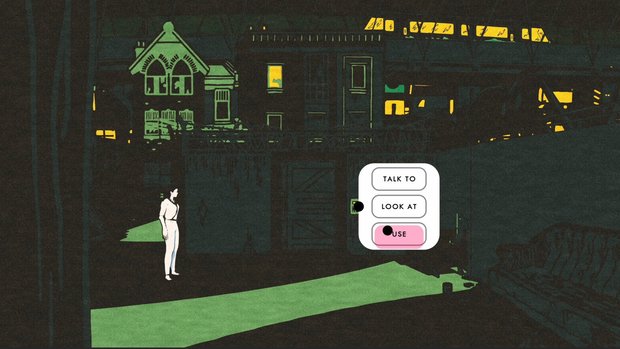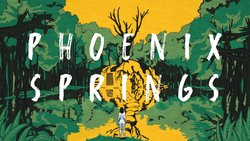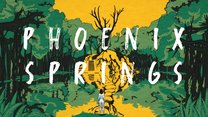Phoenix Springs review

- 0 Comments
Artsy, esoteric mystery rises and falls on the strength of its unique presentation and surreal atmosphere
If you watch the trailer of Calligram Studio’s Phoenix Springs, complete with too-fast-to-read laurel leaves highlighting its festival appearances and awards, you’ll probably be quick to guess that it’s aiming for something a little more arthouse than your average adventure. A moody, neo-noir point-and-click, Phoenix Springs joins the likes of Kentucky Route Zero and Norco as a modern surrealist game, with distinctive visual stylings and a heady, swirling narrative that references everything from quantum physics and bioethics to ancient myths and poetry. You really have to be in the mood for a story that embraces expressionism and ambiguity, but if you can get into that headspace, there’s something about it all that draws you in and strings you along until the end.
You play as reporter Iris Dormer, who, after following a series of clues and leads through a sleeping, rain-drenched city to track down her estranged brother, travels to a mysterious desert oasis village where he had spent some time. “Eccentric” seems too light a word for the inhabitants there, who are seemingly from another realm of thought and society entirely. Clearly there is something more than a little unusual going on in this place, so Iris must explore the settlement and draw what she can from the villagers in order to piece together the underlying mysteries.
The more you investigate, the more elusive the answers become as you encounter unusual sci-fi machines, large dilapidated statues, intense cult-like rituals, and quite a number of folks who could stand to develop a stronger appreciation for wearing clothes. Memory seems to be in short supply as the inhabitants babble about in confused, pseudo-philosophical ramblings and rarely respond directly. As if this isn’t enough, soon even the sequence of events comes into question, as past and present begin to intertwine in disorienting ways.

The developers, while declaring classic point-and-click adventures as their inspiration, have claimed that Phoenix Springs “updates the genre for the modern player” with an interface and interactions that are more streamlined. While certainly not an old SCUMM-style system, it’s actually a touch less streamlined than some other modern adventures, as you won’t find any context-sensitive actions or fast travel here. When you click on a person or interactive object, three buttons appear for “Talk to,” “Look at” and “Use.” As you can imagine, trying to talk to inanimate objects won’t get you very far, and you’ll come across plenty of “I can’t do that” types of responses, but fortunately there are some nice little bits of writing included here. When you “talk to” the city seen through your apartment window, for example, your character responds with a perfect noir-style response: “Shouting at it won’t help. Wouldn’t be the first to try, though.”
While the emphasis on inventory-based puzzle solving makes it feel a bit more traditional in format than other experimental adventures, the “inventory” in this case is a mind map of clues that you can use to make connections. Rather than physical objects, you might collect places, names, events, or even concepts that you store in an array of words to pull out and use on the environment in typical point-and-click fashion. If you use a word on another character, this is the equivalent of asking that person about the topic, and can reveal more clues through the dialogue.
You can also combine a word with objects in the environment to probe for potential connections. If there’s a relevant association to be made, this will prompt Iris to comment on the possible link and potentially open up further inventory options. For a simple, hypothetical example, you might wonder if the John Smith in your inventory is the same as the “Mr. Smith” mentioned in a handwritten letter, so you can “use” the name on the letter to explore that connection. Even in the few instances where you need to actually perform a physical task or use an item, you’ll have to derive the need to do so by making these mental links first, which does feel more sensible than looting the world of seemingly useless objects that you might happen to need later on.

I really enjoyed this approach to puzzle solving, as it allowed for a seamless blend of deductive investigation, dialogue options, and inventory puzzles within this single mechanic. Early on, when the game is more grounded in its setting and storytelling, the sleuthing felt natural, even with the occasionally obscure connections that had me working through combinations with a trial-and-error approach. But things take a different turn both in tone and in puzzles when you arrive at the titular oasis town. Nearly everyone you meet there will respond in strange, poetic-sounding non sequiturs and the clues you gather can start to feel esoteric.
While this shift is intriguing in a narrative sense, it starts to tip the scales of puzzle quality towards frustrating. With very little sense of logic or familiarity, the scenarios become less about “Aha!” moments of insight and more about “Oh, so that ended up working, I guess.” It’s not so bad when the number of possibilities are kept relatively small, like when it focuses in on a specific location towards the end. But when you’re given access to the whole village to explore, and nothing and nobody is making any sense, it can leave you wandering in circles combining all of your word inventory with everything you see. In hindsight, these puzzles do have an internal logic to them, but it’s hard to pick up on beforehand.
The art direction of Phoenix Springs is a particular highlight, with hand-drawn illustration and animation bathed in a bold, minimalist color scheme. Each screen and occasional interspersed cutscene is framed with an eye to the overall composition and blend of hues, like a panel in a graphic novel. The stark yellow sky and dunes of sand beyond the village stand in contrast against the deep green of towering trees nearer the oasis, punctuated further with saturated red cabins, bridges, and other structures that are scattered throughout the settlement. I don’t know how many specific shades of color there are in the whole game, but it can’t be much more than ten.
The animation is subtle, and there’s often not much motion beyond Iris walking and slight movements of the characters you meet. However, a few environmental effects like rain and falling leaves, as well as a textured overlay that creates a frame-by-frame hand-animated look, keep each scene from appearing stagnant. The visual style suffers only slightly when you’re trying to make out particular details, as some of the character models and darker environments can get a little muddy and indistinct. When you put your cursor over something you can interact with, a label appears telling you what it is, and this was useful in scenes where it was difficult to make out who or what I was looking at.

Iris is fully voiced, narrating her investigation in emotionless, terse, but insightful observations of the world around her. The characters she meets aren’t similarly voiced; instead their statements are quoted, paraphrased and commented on by Iris herself, allowing all of the increasingly strange events to be filtered through her perspective. In classic noir fashion, the voice acting is low and monotone, but maybe a little hard to hear in this case, though there are audio options that can change the mix to help with this.
The music is sparse but effectively eerie with its slow, swelling synths and falsetto, discordant choir vocalizations. Most of the time, though, the only thing you hear is the undercurrent of ambient sounds, like traffic noise in the city, wind blowing through the desert, and water burbling under a wooden bridge. The relative silence only serves to heighten the hypnotic feeling of mystery and desolation.
One could perhaps wish for a few more quality-of-life features, like a hotspot highlighter or more in-game hints beyond just a button that links to a full walkthrough on the developer’s website. The thing that almost got me, though, was a lack of manual saving. The game autosaves your exact state and position when you exit, so when I once got stuck on some geometry near a cabin, I quit and restarted only to find myself still stuck, with no way to restore a save or go back to a previous point in the game beyond completely wiping my progress and starting over. Fortunately, clicking around sporadically for two or three minutes finally freed me up and spared me this fate, but autosaving only at a safe position in each area might have been a better choice.
By the end of the game, you’re not left completely in the dark as to what is actually going on with your brother and Phoenix Springs…more like a very dim room with only a little light streaming under the door. At its root is a sci-fi-tinged rumination on identity, time, and rebirth (hence “phoenix”), but how any of the pieces fit together is anybody’s guess. It reminds me of a David Lynch film or something like Donnie Darko in that its dreamy, heady storytelling suggests that there are probably answers in there somewhere, if you dedicate yourself to studying it more closely and unraveling the clues, but it might be just as rewarding to form your own interpretation. As such, it certainly leaves an impression and had me thinking about it after the credits rolled, but also lacks the emotional payoff of a clear resolution or even a firm sequence of events.
Final Verdict
Like an offbeat friend that consistently talks a little above your head, Phoenix Springs isn’t too concerned with how much you grasp of what it has to say through its cerebral, nonlinear storytelling, but I couldn’t help but nod along in pleasant fascination. Investigating a surreal, sci-fi mystery with an inventory of thoughts is engaging, though the more the story veered into abstract territory, the more “investigation” became “blind experimentation,” and a little fatigue started to set in. Fortunately, the game is only around five hours long, so it doesn’t overstay its welcome. Pushing through some of the more confounding bits is rewarded with … well, even more confounding bits I suppose, but in some ways, that’s part of the fun. Soaking in this enigmatic exploration of time and memory, bolstered by a vibrant graphic style and ambient sound design, is a unique experience I’d recommend to any adventurous sort who is interested in the art side of gaming. Just don’t ask me what any of it means.
Hot take
Phoenix Springs will land well with anyone looking for a complex, experimental mystery with striking art and a surreal atmosphere, so long as they don’t mind wrestling with a strange, disjointed narrative and a few obtuse puzzles in an increasingly bizarre second half.
Pros
- An absorbing, enigmatic story that will leave you guessing
- The mind map style of inventory works really well as an investigation mechanic
- Lots of good noir-style narration delivered with appropriately dry voice acting
- Vivid art and minimalist soundtrack are effective at drawing you in to the peculiar setting
Cons
- The latter half of the game is so strange as to be a bit alienating
- A few of the puzzles are obscure and require trial-and-error
- Some darker scenes and certain character models are too indistinct to clearly identify
- I still don’t know what happened…
Brian played Phoenix Springs on PC using a review code provided by the game's publisher.











0 Comments
Want to join the discussion? Leave a comment as guest, sign in or register in our forums.
Leave a comment